
This entry marks the end of my life in Ubuyama-mura, and so I am retiring my old banner for a new one. I think it is a good image for the blog up until now, but it is time to move on and to start afresh.
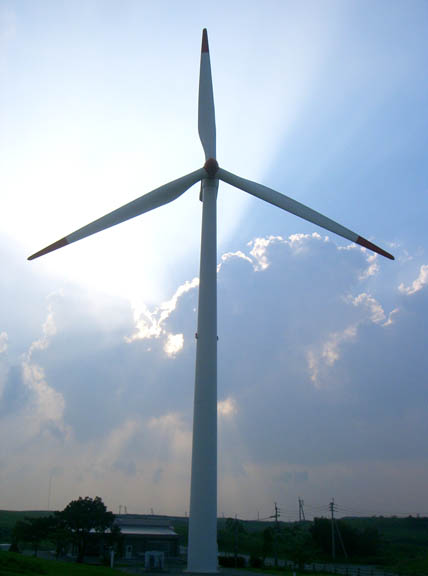
I have been meaning on posting pictures from all around Ubuyama with the purpose of making my own guide to the village for a long time, and today I finally sat down and did it.
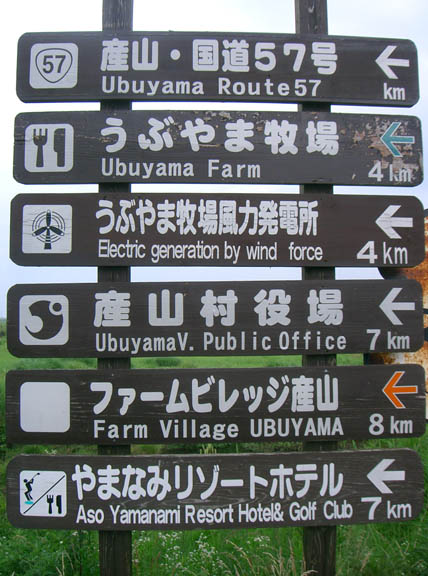
I was pleasantly surprised to find that the great majority of signs in my village are labeled in Japanese and English. I do wish that they kept the sign as "Pubic Office" for the picture's sake.
Ubuyama is a really small village with a population under 1,800 and falling. There just aren't an abundance of jobs and young people tend to move out of the village in pursuit of employment, relationships (there just aren't many young people around), or entertainment. Lacking these staples of life, many would ask "Why would you choose to live in some place so remote?". Well, I can tell you that the reason why I stayed 2 years were for the children, the natural setting, and being in the center of Kyushu. I loved teaching here because the younger children were so enthusiastic about learning and because I felt that I was making a difference in their lives.
I enjoyed teaching at middle school too, but I didn't get to set curriculum and the students tended to lose their enthusiasm for English due to the radical change in lessons. From nursery school until elementary, the lessons were full of games and conversational English, but from their first day in junior high school without any transitional period, they were pushed to learn by rote memorization and much of the fun and spontaneity instantly vanished. Luckily, some of the kids retained their interest, and I tried to keep their attention by making unconventional lessons and incorporating games whenever I had the opportunity.
But this post isn't supposed to be about my teaching experiences, it's about introducing Ubuyama from my perspective. For this, I will examine the village as a whole and then break down Ubuyama into three main areas: Hokubu (Northern Ubuyama), Yamaga (Central Ubuyama), and Nambu (Southern Ubuyama).
Ubuyama-mura
Ubuyama is located North of the Aso mountains and South of the Kuju mountains, next to the largest caldera in the world (Aso Caldera). It is surrounded by Oguni (Northwest), Ichinomiya (Southwest), Namino-son(Southeast), and Oita-ken's Kuju-machi (Northeast). Being in the center of Kyushu is a double-edged sword situation. It means that you are exactly in the middle of the mountains away from civilization, but being here allows you to explore the whole of Kyushu much easier than if you lived on the coast. Ubuyama is 2 hours East of Kumamoto City and 1.5 hours West of Oita City, if you drive Route 57. Beppu is 2 hours Northeast and Takachiho is 1.5 hours to the South. If you are interested in coming to Ubuyama the easiest way is to ride Route 57 to Namino, and to turn onto the 40 (there is a traffic signal). From there, the signs are clearly marked in English so it should be pretty easy to find where you're going.
The economy of Ubuyama is dependent on two things: agriculture and tourism. The farmers in Ubuyama have maximized the available amount of arable land by creating terraced plots of land and scalloped rice fields. Crops grown include onions, cabbage, daikon, shiitake mushrooms, spinach, takana, and other vegetables. Sake and shochu are also locally produced.
Tourists generally come to Ubuyama for the spring water, to visit Ubuyama Bokujo (farm), to eat the beef at Ubuyama Farm Village, or to visit the ryokans and the onsen in Hokubu. The three main things that people know Ubuyama for are 1. Ubuyama's water, 2. Ubuyama beef, and 3. The windmill at Ubuyama Bokujo.
Ubuyama has 1 nursery school, 2 elementary schools, and junior high school. There are plans to combine the elementary schools and the junior high into one school in the future, and plans are in the works to build a completely new and expensive set of buildings to allow this (around Ubuyama JHS), but funding for the project is questionable at present.
Kyushu doesn't generally get as cold as Honshu, but Ubuyama (as well as the mountainous regions in Aso and Kuju) is an exception. Here are some examples of what I mean by this:
I was able to snowboard around town last winter.
Some friends from Hokkaido say that living in Ubuyama is colder than living in Sapporo (because houses in Kyushu are constructed without insulation and kerosene heaters are the main source of heat).
My sink grew an icicle, and all of my pipes have frozen on several occasions.
Everyone has snowtires in town, and chains are highly recommended during the winter.
During my first winter, I wore 3 layers of winter clothes under my parka when I went to bed to avoid freezing to death.
I went snow hiking on Kuju in April.
As a side note, Kuju is the coldest area in Kyushu, and has (small, over-priced, and crappy) ski resort. If you plan on driving on the Yamanami (last picture in the series) during the winter, I highly recommend bringing chains along.
However, summer is the best time to live in Ubuyama because it doesn't get too hot, and no matter how hot it gets you can rest assured that the people in the city are drowning in their own sweat! This is one part of Japan where you won't need more than a fan to keep cool during the summer.
By far, my favorite season is the spring because this signals the end of the brutal cold and that hanami, or cherry blossom viewing parties, are right around the corner. If you ever plan on visiting Japan, the hanami party is something that you must experience. You will know you have come during the right time because you will see flowers exploding into full bloom all around you.
Hokubu
Hokubu was my favorite part of Ubuyama because it was the most scenic area, had the most restaraunts, and because I loved teaching at Hokubu Hoikuen (nursery school). The residents of Ubuyama are fiercely independent and proud of their village, and within Ubuyama, people from Hokubu, Yamaga, and Nambu are even more proud of their individual turf. Until last April, this village of roughly 1,800 people had 3 nursery schools for about 60 children. The main hoikuen had about 45 kids, Nambu had 8, and Hokubu had only 7. I loved teaching such small classes, but it just didn't make economic sense for there to be 3 nursery schools (class size has dramatically decreased in recent years and shows no signs of stabilizing).
At the Undokai (sports festival) you can still see the rivalry between the three main areas of Ubuyama. The teams are divided into 4 teams comprising of Hokubu, Yamaga, Nambu, and an extra for the Yakuba (the public office). The competitions are all in the spirit of comeraderie, but nonetheless the areas remain individual social circles with complex ties to one another.
One strange thing about Ubuyama is the abundance of the Surname "I" (the Kanji for "I" looks like "#"). I would estimate that about 50 percent of the population are "I" followed by Takahashi, and Kudo. There are a few Yoshida's residing here, but they use a slightly different kanji for "Yoshi" the lower line on the "tsuchi" kanji is longer than the upper one. Kanji is friggin'- difficult sometimes.
Driving Hokubu
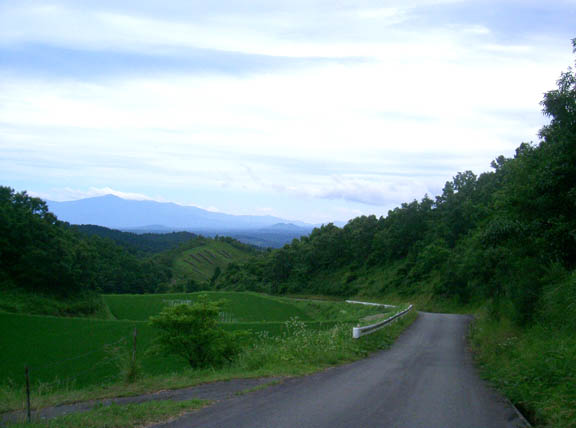
With the exception of the latter part of the 40, and the alternate route to Hokubu branching from the 131, the roads in Hokubu are quite narrow, windy, and range greatly in their steepness. This is just one of the countless country roads (this one is coming from Yamabuki Suigen- the better of the two springs in Ubuyama in my opinion) that wind through Ubuyama around Hokubu. Hokubu boasts the best views in the village, and is located close to the Yamanami Highway (the 11).
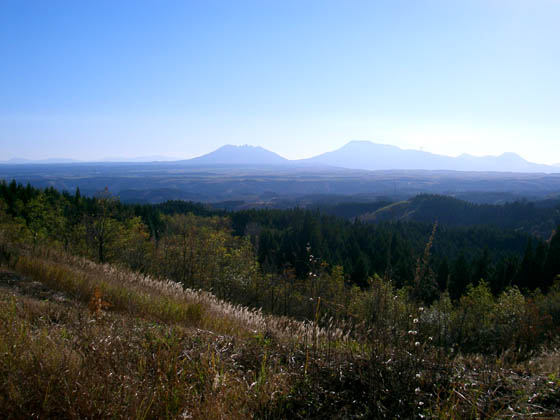
This is taken on a dangerous gravel road close to Higothai Koen, leading to the Herb Garden (where you can buy all sorts of dried herbs). The ridges in the distance are the Aso mountains. The Aso Range is said to resemble a sleeping Buddha (the head is to the left, the feet to the right).
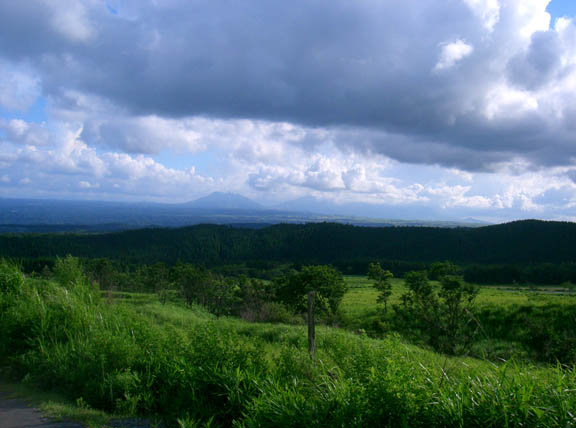
This picture is from the same area on a different day. It is amazing to see the landscape change with different conditions in foliage, lighting, and weather. My favorite seasons are during the winter when there is snow (although it is very dangerous to navigate the steep, windy roads in these conditions) and spring. The grass grows with such speed and vigor, as if the soil itself was pure Miracle Grow.
Higothai Koen
Higothai Koen is located past Ikeyama suigen, next to the campgrounds and the Yamanami Highway. It commands a great view of Kuju to the North, and Aso to the South. Here are some previous posts about Higothai Koen:
Higothai flowers
Thistle
Lavender flower and a bee (3rd picture down)
Bathing in Hokubu
Hana no Onsen is a nice spa located right next to Ikeyama-suigen. Also on the premises are a greenhouse flower garden, a bakery (I recommend the deserts here), a gift shop with all sorts of special food products, and a restaraunt.
If you are uneasy about taking a bath with strangers, you can rent out a private bathroom (called a family onsen) for 1,000 yen an hour. My favorite time to go to the onsen is during the winter, when you can bathe in the outside bath and experience the cold air and hot water as snow falls all around.
If you are really into onsens, there is another near the Yamaga region. I never went because my predecessor, Harvey Haynes, described it as a "mud pool".
The Springs Of Ubuyama
The two springs of Ubuyama are Ikeyama suigen and Yamabuki, both of which are located in Hokubu. The rate at which water gushes out from all around these areas is astounding, and gives a whole new perspective on percipitation, groundwater, hydrodynamics, and of watersheds in general. People come from far away and fill up all sorts of vessels at the springs (restaraunt people are usually the people that you see hauling masses of 5 gallon jugs to and fro).
Ikeyama is the more popular of the two, and the easiest to access. Always being warned about the dangers of giardia and coliform bacteria contamination, it is still strange drinking unfiltered water straight from the source with waterstriders, frogs, and minnows darting around, but it tastes excellent. There is a fishing pond here filled with farmed yamame (a salmonid not unlike the brook trout of Northern California), a restaraunt, and an unattended vegetable stand, where you pay on the honor system. The best time to go is on a late June night, when no one is there and the fireflies are out.
Yamabuki suigen is among the most rural areas in Ubuyama. It takes more time to get to the parking lot and to hike to the spring, but it is well worth it. I have seen foxes, voles, and various other wildlife here in an abundance above the surrounding area. The relatively untouched woods and meandering streamlets running through them provide a refreshing 30 minute round-trip hike. This is my favorite place in Ubuyama, and I often came here to recharge after an especially stressful or tiresome day at work.
I have never spotted any mamushi around the springs, but they are said to be abundant. I suggest not playing with snakes of any kind around here, as if you are bitten by a mamushi (a pit viper native to Japan) there is a good chance that you will have screwed yourself proper.
Dining in Hokubu
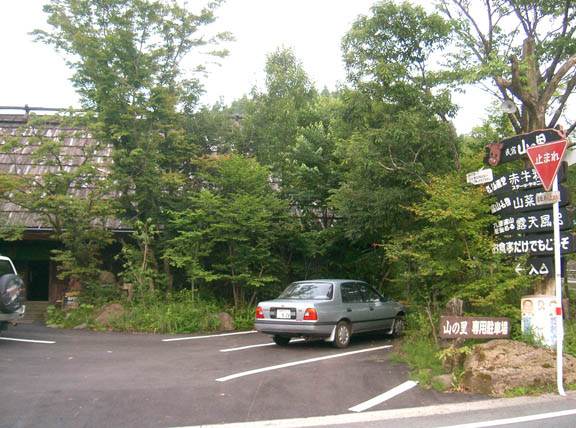
I meant to take a better picture of this restaraunt, but didn't get a chance. The family of one of the teachers that I worked with at Hokubu Hoikuen runs this place. They serve wonderful steak here that comes from the farms of Ubuyama. Ubuyama beef is delicious, and has recently gotten sort of famous around Japan. But Japanese beef is expensive, especially after the BSE issues with American beef. The cheapest steak here will set you back about 3,000 yen (but I went a year ago, so prices might have gone up). However, this place does steak exceptionally well, and they have about 30 varieties of otsukemono to choose from, all made from local produce. The yakiniku is also really good here. The staff is very nice, and the fact that they don't speak English will not prohibit a non-Japanese speaker from having a wonderful dining experience. From the 40, follow the signs to Hana no Onsen (Flower Spa), and you will see it on the right-hand corner of the road that runs straight toward the onsen and Ikeyama Suigen.
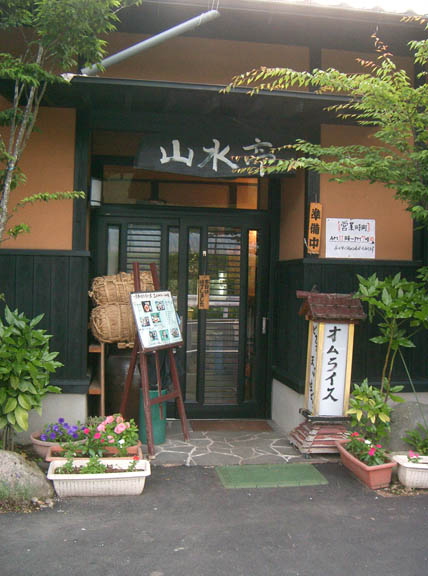
This place is pretty famous, and located right between Hana no Onsen and Ikeyama Suigen. Their specialty is a huge omraisu(an omelette with fried ketchup and ham infused rice in the middle), but my recommendation is the inaka tempura.
Yamaga
Yamaga is the central part of Ubuyama and has the main street, called Yamaga Street. Along here you can find 3 gas stations (Chevron, JA, and Eneos), The post office, JA(Japan Agricultural- a true sign that you live in the middle of nowhere) Bank and Insurance, an auto-garage (that services tractors, rototillers, and other farm equipment mainly), the post office, the public office, two proto-convenience-mom-and-pop stores (not that convenient and overpriced), the middle school, a community center, possibly the oldest house in Ubuyama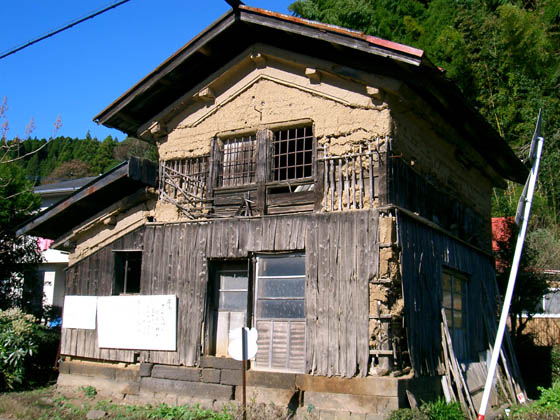 , and the newly completed indoor pool (where they got the money for this I have no idea, but whoever talked the Japanese Government for funding this must be a financial and political stud).
, and the newly completed indoor pool (where they got the money for this I have no idea, but whoever talked the Japanese Government for funding this must be a financial and political stud).
The Bridge
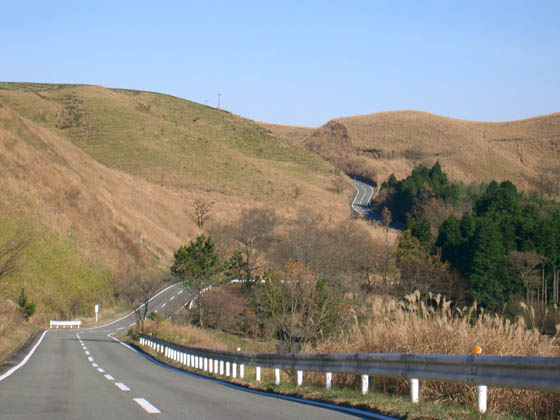 This is the road leading from the Yamanami Highway (Route 11) towards the 40 and Ubuyama Bokujo (Ubuyama Farm). Why they built the bridge is beyond me- they really don't need it, as the 40 and the 131 lead to the Yamanami already... It's a nice bridge though.
This is the road leading from the Yamanami Highway (Route 11) towards the 40 and Ubuyama Bokujo (Ubuyama Farm). Why they built the bridge is beyond me- they really don't need it, as the 40 and the 131 lead to the Yamanami already... It's a nice bridge though.
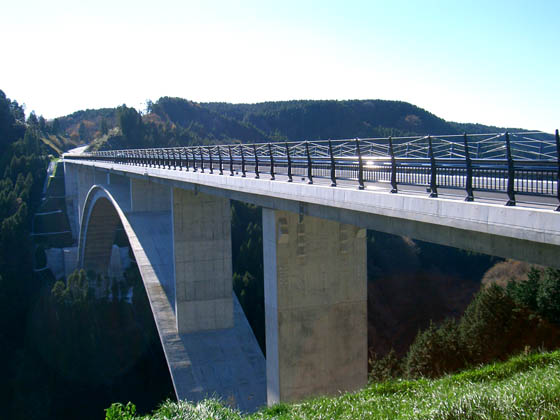
The gorge below is so deep that this place would make a perfect place to bungee jump. Later at night no one comes around here, and traffic during the daytime is sparse. Due to the rugged terrain and unforgiving foliage below, base jumping is not recommended.
The Dam
Ubuyama Dam is being completed as I type, and should be operational by the beginning of next year. The dam is a fairly large one, located between the bridge and the Yamaga strip.
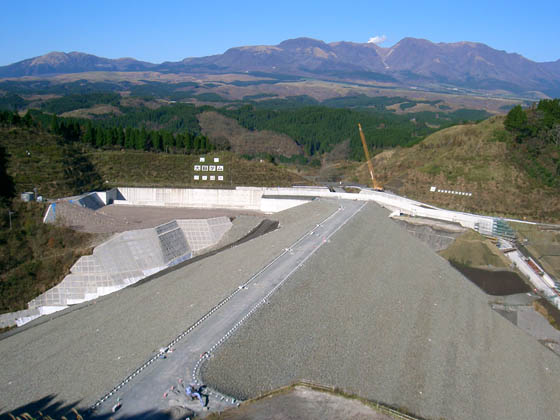
When I first heard of the dam, I was quite impressed because I thought that it was to be a source hydroelectricity. Unfortunately, this dam's purpose is to create a resovoir, and will not have turbines in place. The budget for the dam was approved during the bubble economy era, and similarly unnecessary projects (like huge bridges leading to tiny rice fields and such) were approved during this time all over Japan by the Government. The dam really not needed, as Ubuyama is blessed with two fountains that provide a constant, inexhaustable watersource year round.
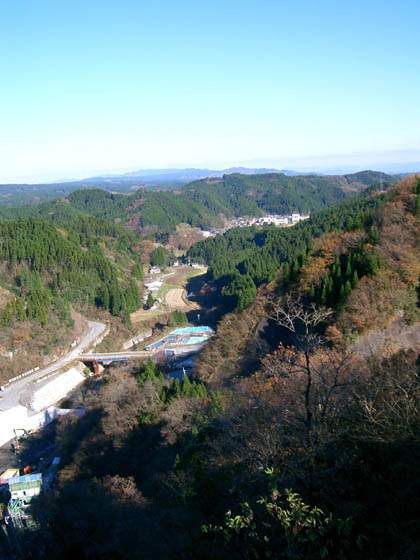
I think that the dam will only lead to problems including squandering a bountiful water supply (through accelerated evaporation of a standing body of water), maintainance costs of the dam (siltation and debris looks to be a major possible problem here), and the inherent risk of placing a large body of standing water right above the area with the largest population density in Ubuyama. I mean, I don't really expect the dam to fail, as it is quite expertly and robustly constructed. However, IF it ever did, the water would come rushing down along the contours of the land and flood the Yamaga strip, pictured as the clump of white structures in the distance. Not everything about the dam is useless, though. I predict that the dam will result in some awesome bass fishing for the residents of Ubuyama...
El Patio Ranch
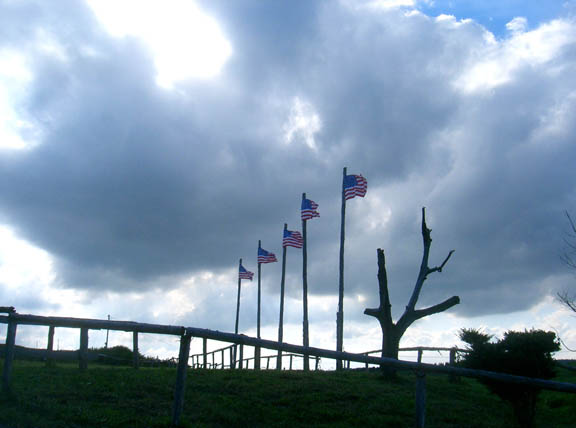
One of my favorite places to visit, the sight of five American Flags flapping against the dramatic skies of Northern Aso have always brought to the surface the proud feeling of being American. You might notice that the flags from my banner are from an older, weather-torn batch of flags of El Patio.
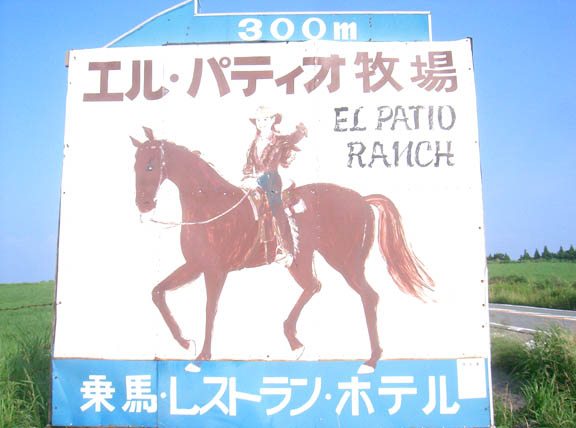
This sign, minus the katakana and kanji, is not unlike signs that I have seen in rural, touristy areas of America. I never wanted to ride the horses here because they have one cheesy riding path for you to follow. There is one other place on the Milk Road called Reverce R Ranch where you can ride horses, but I never checked this place out either.
Golf Resort
I have never golfed here, but I hear that the course is nice. I have, however, eaten at a banquet at the hotel, which was pretty good. The road next to the entrance to the Golf Resort is really fun to drive though, and has the feel of a stretch of the World Rally Championship course (the leaf litter can make you slide on the sharp curves, and there are often fallen trees or rocks blocking parts of the road so you should take a preliminary scouting run before attempting this stretch). There are no guard rails to prevent you from launching your car over the side of the mountain, so go easy on the power-sliding.
Towards Kuju
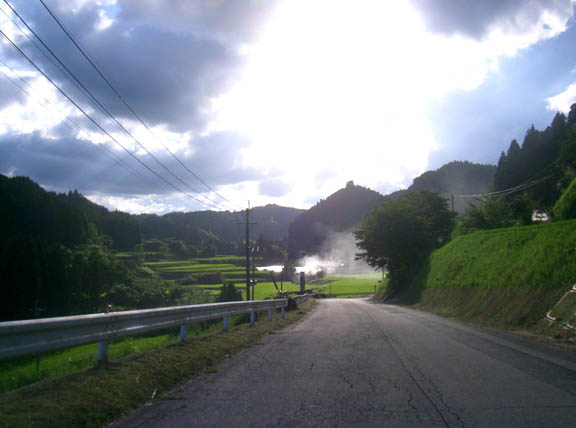
By car, it is less than 5 minutes from my old house to Oita-ken via the 131 towards Kuju town. Taking this road will take you towards Kuju Hana Koen (an awesome flower park- best time to go is when the Cosmos are in bloom during mid Fall), Kuju Beer Kogen, Guersney Farm (you should see the katakana for this bokujo), the French Perfume museum, and other charming places out in the sticks that you wouldn't expect to find. This road is great to drive because there is never any traffic.
Ubuyama Chugakko
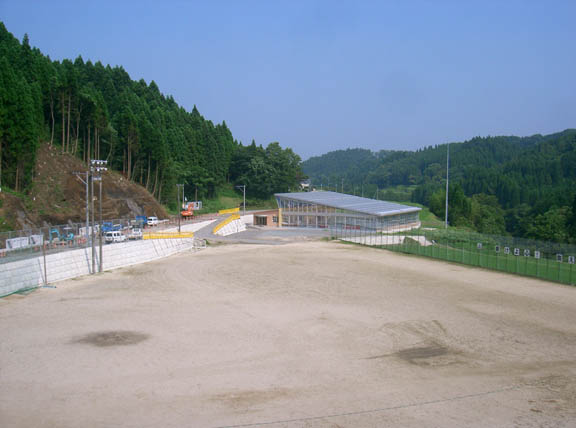
This is the view from the 3rd story of my chugakko, from the end of the hall. The new swimming pool is visible, just past the baseball field. I always wondered why in Aso, where grass of such lusciousness grows with such speed and vigor, everyone prefers to play on a sand lot. Much time is wasted weeding every week (if you don't do this then the weeds will be knee high within a month), and I think that grass is a better landscaping medium for sports. Way in the distance are the hills of the Nambu region.
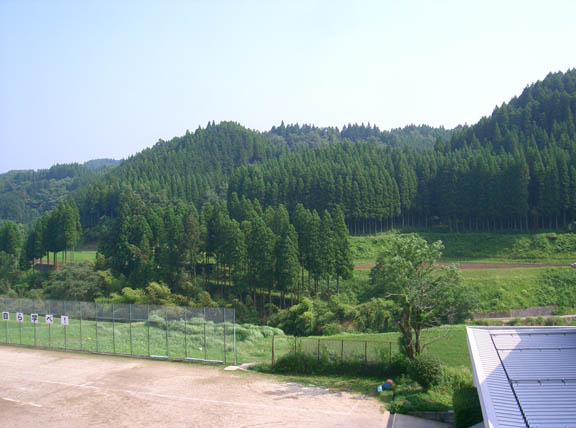
This is the view that I had for 2 years in my chugakko. I don't think many teachers get a better view than this.
Yamaga Shogakko
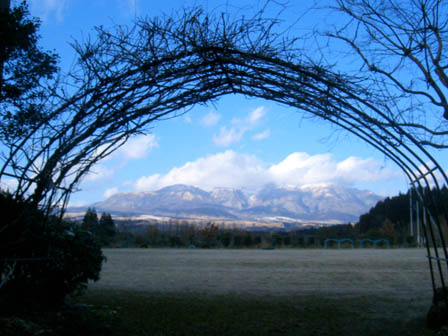
Yamaga Shogakko is one of two elementary schools in Ubuyama (the other one is located in Nambu). This is the best place to be in the summer, as there are never any mosquitoes, it is the highest point in the Yamaga strip and, there is often a nice cool breeze. Yamaga was my favorite place to teach, as I was able to lead in the development of the curriculum here with the support of all of the teachers. The road leading up to Yamaga Shogakko makes for the best ski slope in Ubuyama during the winter.
Ubuyama Bokujo
Ubuyama Bokujo (top picture), or Ubuyama Farm, is really just a glorified petting zoo. They have rabbits, horses, a mean pony, geese, goats, ducks, and sheep in enclosures next to the main complex that you can feed. The wide grassy fields surrounding the bokujo would make a great place to walk barefoot except for the abundance of sheep pellets and dog turds, making a stroll into a real-life game of minesweeper. If you put down a tarp, the bokujo would be a nice place to picnic but the two resident overweight collies will harass you like a pair of jackals, and often bully little kids into handing over their bentos.
Inside the bokujo is a decent restaraunt that specializes in Ubuyama beef and soft serve made from Ubuyama dairy. Here you can also buy locally produced products and rent out bicycles and mountainboards. Unfortunately, the hills are too gradual to really build up any speed on the boards.
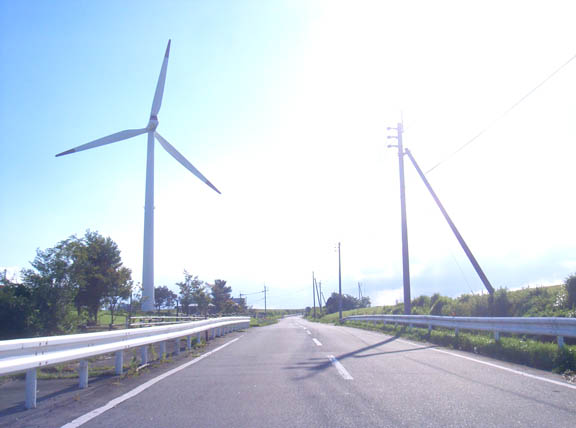
The windmill is what most people remember about Ubuyama, hands down (the second, third, and fourth most recognized features being the suigens (springs), the beef and the onsens). From the windmill, you can see the haunted hotel in the foreground, if you look toward the towering golf resort hotel.
This is THE place to go if you want to indulge your testosterone-induced impulses. Filled with bats, animal droppings, broken glass, and mold, you can go wild here and smash stuff to your heart's content. Just a tip: girls tend not to find such activities "amusing" so you might want to make this a "guy" trip.
Warning: People tend to hurt themselves here in their enthusiasm. Kelvin cut his hand while jumping and smashing a chandelier with two 2x2s and Joe Fingerhut hyper-extended his thigh when kicking down a locked door. Also, going here is "frowned upon", and local residents may get upset if you make too much of a ruckus.
Nambu
If you veer right off of the 131 after passing Ubuyama Chugakko, you will be heading towards Nambu, the Southern region of Ubuyama. This area lies between Kuju and the 57 and has many small roads to be explored. A few interesting people live here as well.
Cool Old Stuff
In Nambu, you can find some interesting things that not many people know about. One is a very old stretch of cobblestone road called the Bunkokaido Road, of which two sections still survive in Ubuyama. According to the internet (always a reliable source of information, right?), some sections survive in other places including Aso-machi and Ichinomiya-machi, and it stretched from Kumamoto City to Oita. It ran a total of 125 kilometers, back in the day. Interestingly, no one in town seemed to really know much about this road at all.
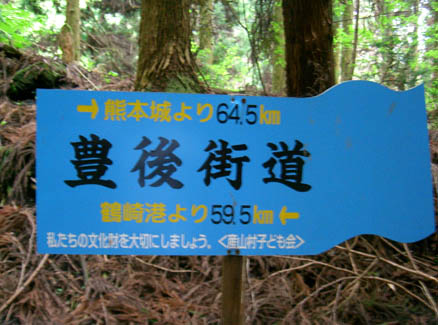
Around this area, just off of the cobblestone road, you can find a supposedly famous tree that was struck by lightning and continues to grow. According to the Japanese signs it is of interest for some reason, but I liked this place mainly because I found a snake lounging around the precipice on which the tree resided.
People
One is a potter who moved here from Kyoto into a really old house named Hazawa-san. She makes pottery from scratch from beginning to end, using a special, fine white clay (which she grinds down from rocks into fine powder and reconstitues) and uses a signiture aquamarine glaze with zinc crystals which finely complements her elegant vessels and creations. I predict that her pottery will take off and fetch insanely high prices in the near future.
Another is a couple that hails from Hokkaido, the Akashi's. This couple support themselves by selling homemade tofu and bread, which they bake in an old-school oven.
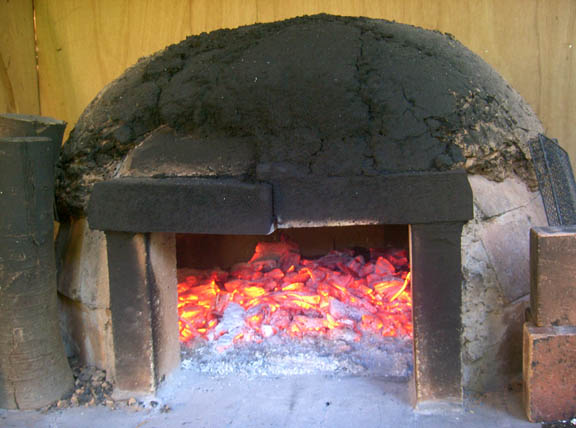
James Michener once described an oven that Afghanistani people used to bake their naan over camel dung (it imparted a "nutty" taste, he described) that reminded me of this one, where Mieko-san baked farewell pizzas for me:
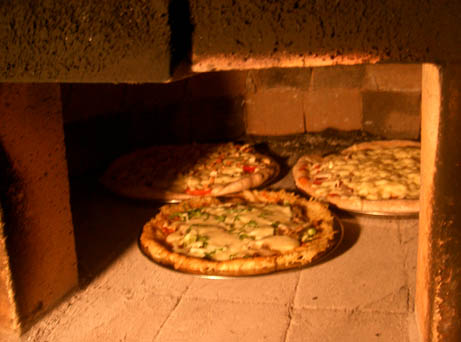
They produce everything that they eat without the use of agrichemicals of any sort (although they do use gas to power rototillers and some other equipment). The view from their house is extraordinary.
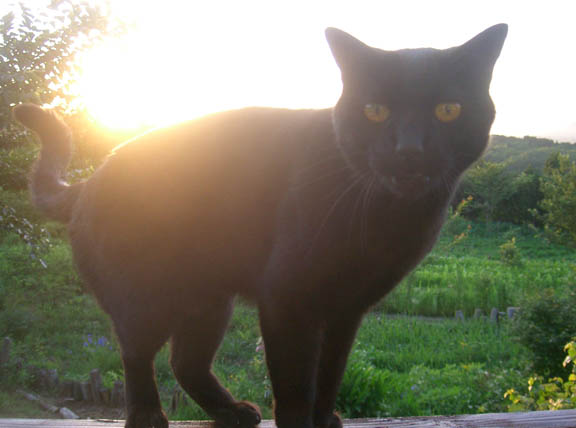
This is their cat blocking the view of their organic fields. Maybe Yoda will look like this (except for one eye) in a couple of years.
It is interesting to note that Nambu was a tense area about a year ago, due to the breakout of Avian Flu (Tori-infuruenza in Japanese), as the largest poultry farm is situated here. This was almost as scary as the possibility of a SARS outbreak to the residents of Nambu, I think. To live in Nambu is to live in the inaka-est part of a place which is already extraordinarily inaka (inaka means country, boondocks, the sticks, the opposite of urban, etc...).
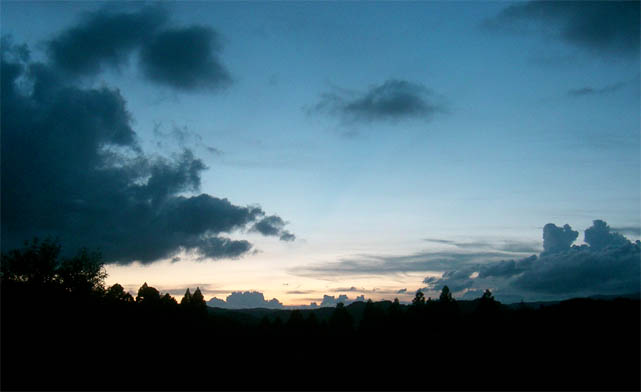
Closing Thoughts
To interact with the people in Ubuyama is to live out an anthropological case study on remote areas in Japan, where the true culture of old Japan has been well insulated against McGrand sandwiches, 50 Cent, and a high-speed internet connection. Here is a place where nature resides in such abundance that it regularly invades your house, where the sounds of a million mating frogs that live in the adjacent rice paddy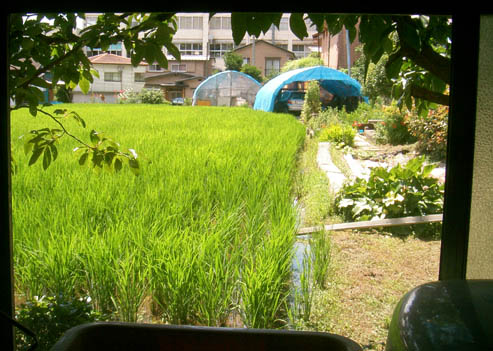 (a view out of the kitchen window) keep you up instead of the sounds of a womanizing neighbor beating his wimpering wife (a common experience among those living in apartments in the cities). Here you can remember what fresh air tastes like only to be reminded of the yellowish-brown skies of Southern-California. And at night you can see more stars than you could ever count, and see everything at midnight under a full moon as if it were still dusk. Here is a place where you want to be when you grow old and long for a peaceful patch of nature where you can savor the memories of a full and happy life.
(a view out of the kitchen window) keep you up instead of the sounds of a womanizing neighbor beating his wimpering wife (a common experience among those living in apartments in the cities). Here you can remember what fresh air tastes like only to be reminded of the yellowish-brown skies of Southern-California. And at night you can see more stars than you could ever count, and see everything at midnight under a full moon as if it were still dusk. Here is a place where you want to be when you grow old and long for a peaceful patch of nature where you can savor the memories of a full and happy life.
Ubuyama Links:
The official page of Ubuyama mura
My predecessor Jane's site
Wikipedia's article on Ubuyama
Ubuyama Farm and Higothai Festival information(via the Kumamoto Prefecture webpage)
The Ubuyama Plateau Beef Festival
An example of inaka ryouri (the local foods)
Yahoo weather for Ubuyama
Camping facilities in Higothai Park
Ubuyama Junior High School
Yamaga Elementary School's page
Kasetsart University Laboratory School (Ubuyama JHS's sister school in Thailand)
Ikeyama suigen (spring)
An example of clamshell rice paddies in Ubuyama at The Asian Rice Foundation
Mountain boarding Ubuyama (now defunct)
Very cool.
Ahoy Adam, How is life in Kansai? Things are just getting strated again here. Waterwheel is Saturday and Aso Hash/Rave the following Saturday. Kumamoto Kids e-camp was pretty awesome. I really enjoyed your Ubuyama rundown, I'll have to get back up there this year. My computer is currently broken, so I don't have too much internet access, but I'm sure I'll talk to you soon, peace
Hi Adam, just finished catching up on your site. Nicely done! Always loved driving in Ubuyama, now I know a few more places to check out. Hope you're doing well in Kansai....seems strange you're there and not "up there" in Ubuyama....be good.
Hey Adam,
I have not had the chance to talk with you and just came upon your site myself. I have been in Ubuyama with Jane since mid October and wish I would have read your site as soon as I got here. You have explored the place with great diligence and I find to agree with most of your opinions. Ubuyama is a very interesting place and the lifestyle appears to very different from that of North America.
Your writing is great for such a young guy, I assume you are under 25, and your pictures are very good as well.
I also want to thank you for the help, time, patience, and undertanding you must have given when Jane first arrived. It was a real shock for her and I understand that you took very good care of her. Thankyou.
I will keep your website in my bookmarks and get your email. I am heading home in ten days but find that knowing people living around the world can only be beneficial. If you are ever in BC, Canada you have somewhere to stay.
Keep up the great writing,
Ryan
To tell you the truth i do not know how i got to this site but i did enjoyed reading and seeing your photo's. Good work!! I am sure when ever i able to see for myself i will have a great reference from your site. I am here in Houston,Texas home of the Houston Astros and The Texans Football team.
Thanks Rick
Wow! My wife's from Ubuyama, I've never visited but it sure looks good. We currently live in the 'Deep, dark north of Japan' well, Fukushima ken actually. Quite a contrast really. Good work!
AndyM
Hi Adam!!
Genki? Watashitachiwa totemo genki!
Can I link up with your blog?
You have many nice photos of Ubuyama, and I don't have any photos on my site, lonly place....
I really enjoy your blog but writings are puzzles sometimes! But your photos are interseting and fantastic anyway! Mieko
Hey Mieko-san, I'm doing well, thank you. Sure you can link to my site- Can you send me the URL of your page once again?
Adam
One of the letter of my URL "~" is different!
Hope you can see my site. Mieko